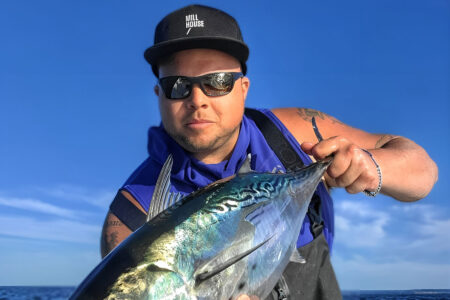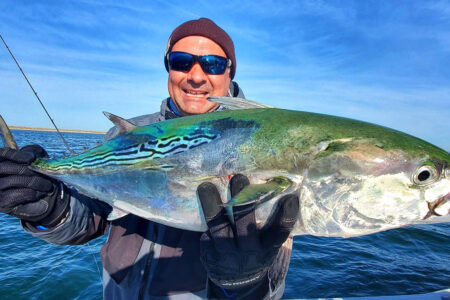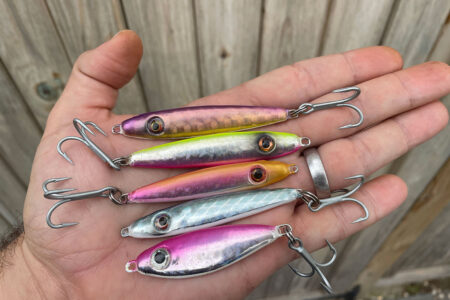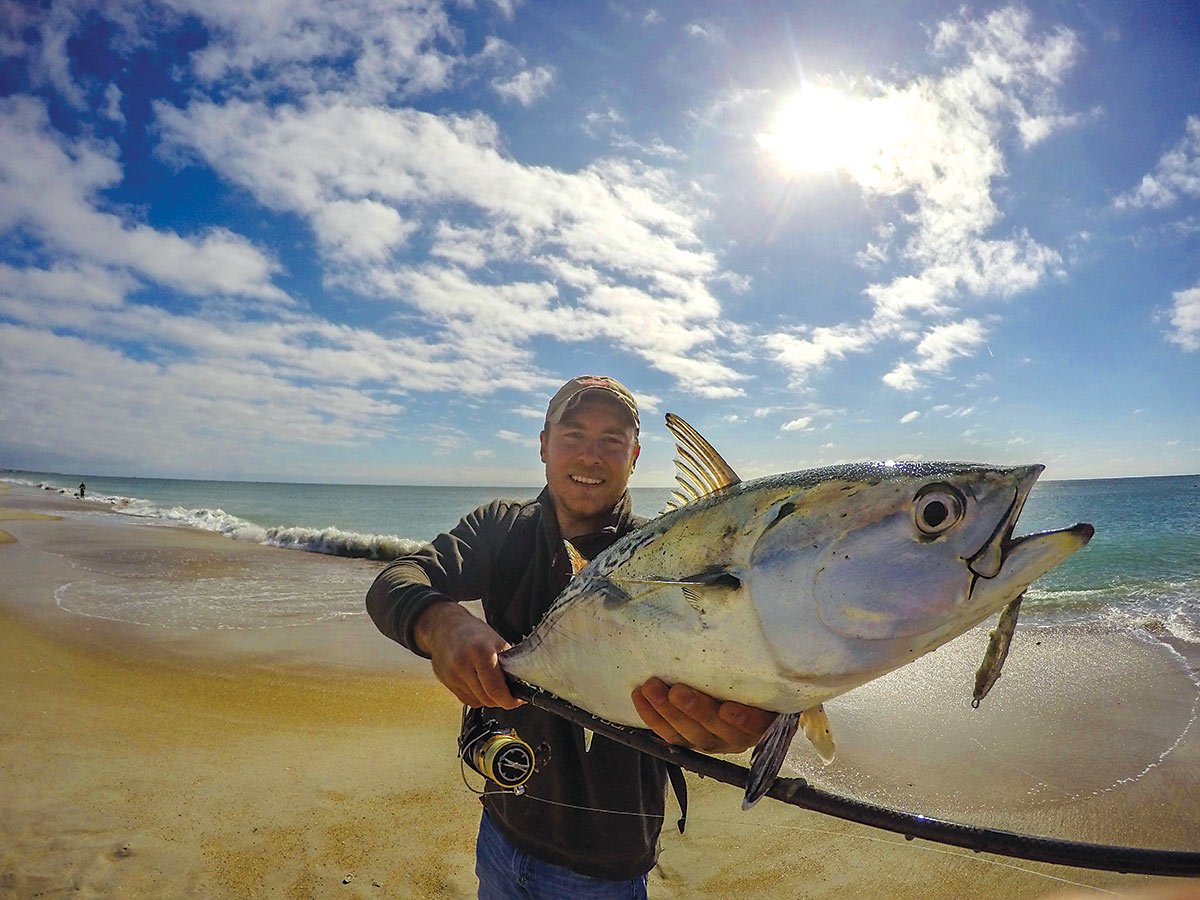
Our late summer, southern visitors arrive fast and come hungry.
Summer and early fall surf fishing gets tremendously exciting when an elite trio of southern lightning – false albacore, Spanish mackerel and Atlantic bonito – race and rampage through the region. They are capable of triggering both ecstasy and agony for those who target them, and their mere presence in late summer inshore waters radically alters the dynamics of working a shoreline.
These three splendid gamefish all possess blinding speed, incredible strength, keen visual perception, and sheer cunning when foraging for food. The secret to hooking up with them is using the right lures, at the most opportune times, while using long-casting techniques and high-speed retrieve presentation tactics.
Skill counts when targeting them; but oftentimes luck is a significant part of the equation.
Speed Demons
All of the southern speedsters share certain similarities while also maintaining distinct differences. Physically, they are all powerful swimmers with relatively small and compact bodies built for speed, exert great strength for their size, are blessed with extraordinary eyesight, and possess forked tails. They are all schooling fish that prefer warm water and like to feed on small baitfish. Their differences are in their coloration, body markings, dentures, where they like to forage for food, and the food value of their flesh.
False albacore have squiggly worm-like markings on their backs and fingernail-size spots on their stomachs. Bonito have stripes on their backs; their bellies are silvery. Spanish mackerel have good-size golden or mustard-colored spots on their silvery sides. Whether inshore or in the surf, these species are difficult to target; you have to play the odds and keep abreast of any reports indicating their presence in the waters that you fish.
First off, they all like warm water and the presence of abundant amounts of small forage baitfish – spearing, bay anchovies and peanuts – holding close to the beach or inlet mouths. Spanish mackerel always seem to lead the way, often showing up first along the Jersey Shore in mid-summer. They are almost always accidental catches for those jigging for bluefish. False albacore, on the other hand, are the most predictable of the three and the most plentiful compared to the other species. They arrive in the Northeast region anytime from mid-September until mid-October.
Bonito – like another inshore speedster you could encounter, the skipjack tuna – mostly prefer deeper waters offshore. Widely scattered surf catches are made, but boat anglers have a decided advantage in the quest to hook up with them.
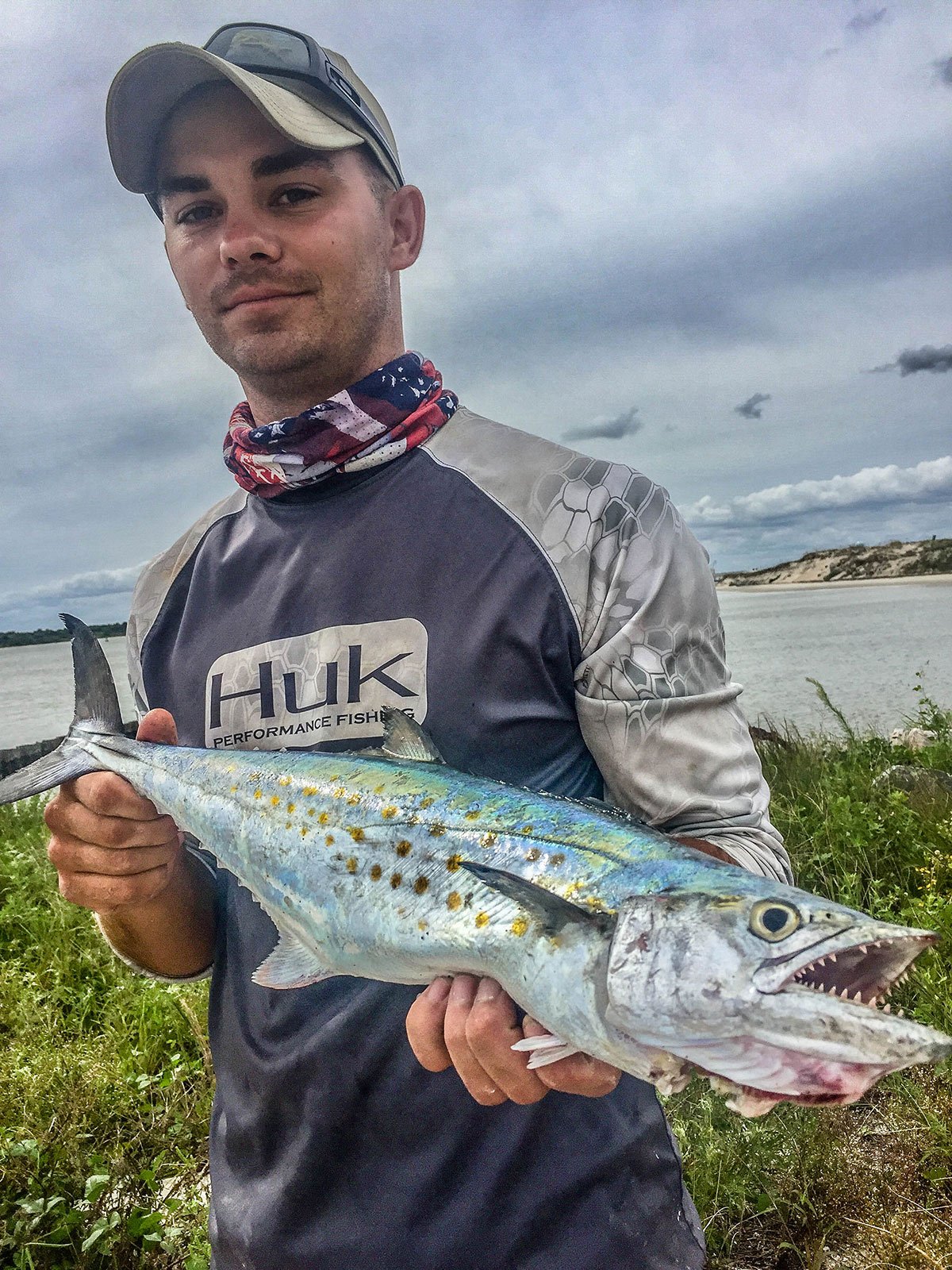
Tools & Tactics
The good news is that the tactics and lures that catch one species will appeal to the other three as well. The requisite tools that you need to make appealing presentations are quite basic, a 9- or 10-foot surf rod capable of making long casts matched with a spinning reel that has high-speed retrieve capabilities. A compatible combo together with the right lures makes for an excellent presentation package.
Do your best to minimize or eliminate the use of hardware such as snaps and swivels; use fluorocarbon line or shock leader. Choice of lures is critical to success, as they should mimic the long and slender profiles of the spearing and bay anchovies that the foursome all seem to crave; whichever lures you use should have the aerodynamics and enough weight so they can be cast well and far. The Crippled Herring, Tsunami SlimWave, AOK T-Hex, Swedish Pimple, and Deadly Dick have all earned great reputations as speedster classic lures.
My personal favorite metals are those designed to be tied directly to your line without any kind of snap. A sampling of such lures includes the 007 and 017 diamonds, the Gibbs Minnow, the Mann-O-Lure, and the Jetty Ghost Minnow. Teasers presented in tandem with metal jigs have proven to be effective as long as you do not use any hardware. These speedsters are excellent hunters, and their keen eyesight makes them extremely wary of anything that looks unnatural; your lures have to look and move like the small baitfish that they seek.
Surf Sense
From mid-summer on, you have to assume that one or another of these speedsters may be feeding in the area that you ordinarily fish. They can be caught in a variety of places when the water is warm and wherever you find the forage baitfish that they depend on for nourishment. This includes stretches of sandy shoreline, inlet and jetty tips, and any location apt to hold copious amounts of a variety of baitfish. False albacore will often enter back bays and rivers in search of food. Low light situations – dawn and dusk – somewhat negate the amazing eyesight of this trio, but they are capable of striking just about any time of the day if the conditions are right. They will hit in rough or calm seas, or whether the water is clean or stained. Tide stage is not a critical factor in most cases.
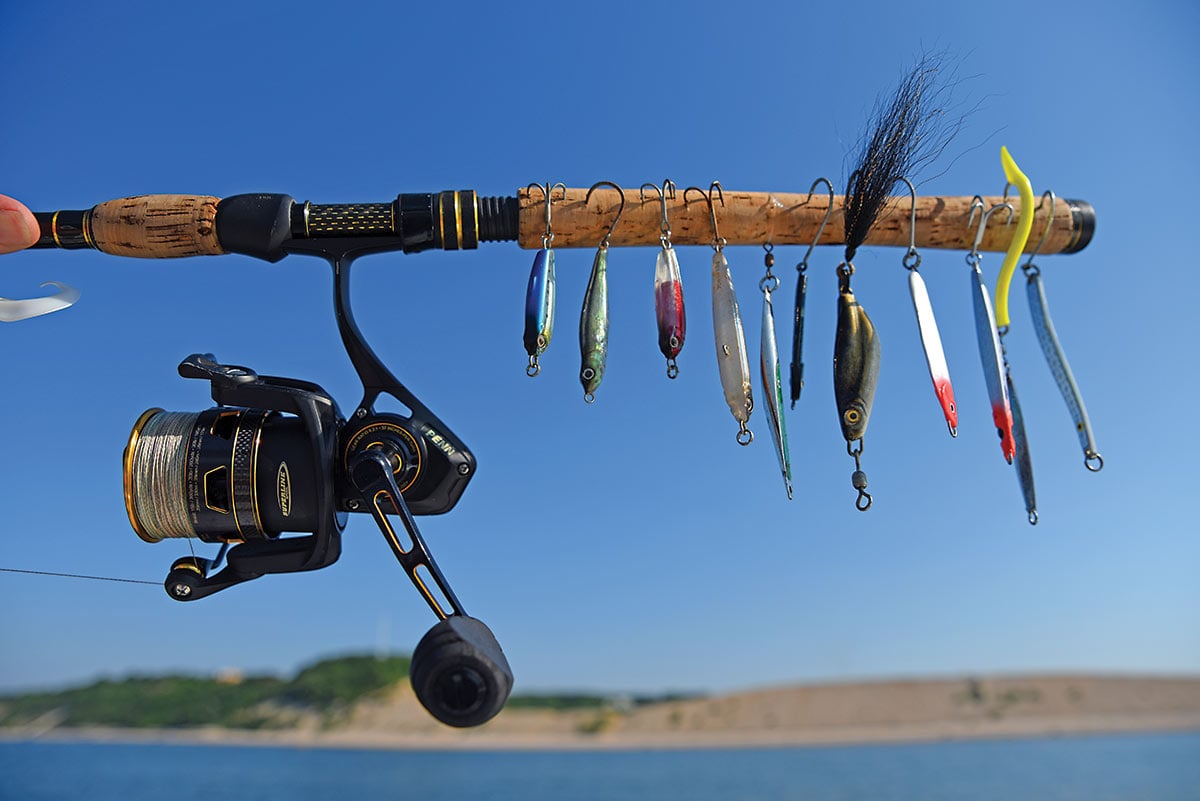
It is important to keep your lure in the water when you know any of these species are in the area. Sometimes you can spot the fish swirling or jumping well off the beach but more often than not they are caught blind. Repetitive casting-and-retrieving – long-distance casting and high-speed retrieves – maximizes your chances of reaching and appealing to the southern hunters. Have a line-up of lures ready to probe the waters; change lures often; cover as much water as possible. Do not chase them up and down a beach like you would a school of bluefish. Hold your position working your lures: the fast-moving fish will find you.
One tactic that often triggers strikes when repetitive casting-and-retrieving does not is the splash and slash. This involves the lures that you would use normally but with a different presentation tactic. You need to close your bail just before your metal hits the water, lift your rod tip dramatically when the lure hits the surface and reel in extremely fast. The splash gets the attention of the southern marauders, and the on-surface high speed retrieve appeals to their hunter mentality. The strikes triggered with this tactic are explosive.
Although relatively small in size, false albacore, bonito and Spanish mackerel fight like much bigger fish. Hook up with any one and you know immediately that you have something special on the end of your line. Hooking these fish is challenging; landing any one of them demands skill and patience. Know beforehand the distinguishing features of each so you can decide whether to keep or release your catch. Spanish mackerel and bonito are excellent table fare; false albacore are not. Any fish that you choose to release should be released as quickly as possible to increase their odds of surviving so they can fight another day.
| TELL-TAIL DIFFERENCES – KNOW YOUR SPEEDSTER |
|---|
|
Spanish mackerel, Atlantic bonito and false albacore are all powerful swimmers with relatively small, compact bodies built for pure speed; they boast keen eyesight and all feed on small baitfish like spearing, bay anchovies, and peanut bunker. While being prepared to strike in that relatively small window of luck and opportunity you might be blessed with this season, it’s important to remember the key differences between the species should you hook up.
|
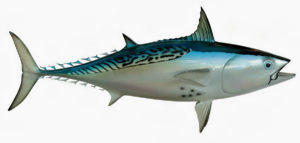 False albacore (also referred to as albies, fat alberts, little tunny, bloody mackerel, falsies) are metallic blue or blue-green body coloration, with squiggly, worm-like markings on their backs and fingerprint-size spots on their stomachs. In the mackerel family, these ablies have a single row of small, inwardly curved, cone-shaped teeth, and while used as bait by some on the offshore grounds for sharks and marlin, most Atlantic coast anglers opt to practice “catch and release” for good reason.
False albacore (also referred to as albies, fat alberts, little tunny, bloody mackerel, falsies) are metallic blue or blue-green body coloration, with squiggly, worm-like markings on their backs and fingerprint-size spots on their stomachs. In the mackerel family, these ablies have a single row of small, inwardly curved, cone-shaped teeth, and while used as bait by some on the offshore grounds for sharks and marlin, most Atlantic coast anglers opt to practice “catch and release” for good reason.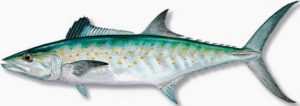 Spanish mackerel (Spanish macks, spotted mackerel, Spaniards) have green backs and silvery bellies, with silvery sides marked with good-size golden yellow or mustard spots above and below the lateral line. A member of the toothed mackerel family, Spanish macks have sharp teeth very similar to those of bluefish and are also prized by many for their table fare. There are two separate populations, one in the Gulf of Mexico and the other on the Atlantic where they winter off Florida and move northward to New York area waters during the summer months.
Spanish mackerel (Spanish macks, spotted mackerel, Spaniards) have green backs and silvery bellies, with silvery sides marked with good-size golden yellow or mustard spots above and below the lateral line. A member of the toothed mackerel family, Spanish macks have sharp teeth very similar to those of bluefish and are also prized by many for their table fare. There are two separate populations, one in the Gulf of Mexico and the other on the Atlantic where they winter off Florida and move northward to New York area waters during the summer months.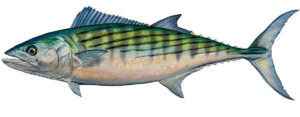 The Atlantic bonito (often spoken as bonita but spelled bonito) boasts a steel-blue or blue-green back with stripes and silvery bellies. Sometimes confused with false albacore because of their body coloration, the two fish differ in their color patterns, body markings, and physical size. Also a member of the mackerel family, Atlantic bonito (not to be confused with offshore Ocean bonito more commonly referred to as skipjack tuna) have more teeth than a false albacore and are often difficult to catch in the surf because they generally are found in deeper waters. It’s an excellent fish to eat.
The Atlantic bonito (often spoken as bonita but spelled bonito) boasts a steel-blue or blue-green back with stripes and silvery bellies. Sometimes confused with false albacore because of their body coloration, the two fish differ in their color patterns, body markings, and physical size. Also a member of the mackerel family, Atlantic bonito (not to be confused with offshore Ocean bonito more commonly referred to as skipjack tuna) have more teeth than a false albacore and are often difficult to catch in the surf because they generally are found in deeper waters. It’s an excellent fish to eat.